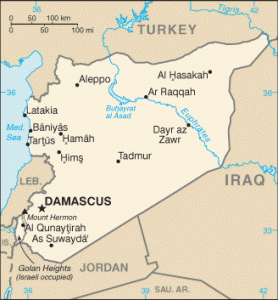The Pentagon and U.S. Central Command have begun a preliminary review of U.S. military options against the Syrian regime of President Bashar al-Assad, as violence throughout the country continues to escalate.
 The most significant violence is reported to have taken place in the city of Homs, where government security forces have bombed civilian areas in their attempt to extinguish an armed uprising against the Assad regime, led by army defectors in the Free Syrian Army. As the crisis worsens, Washington has begun openly talking about intervention.
The most significant violence is reported to have taken place in the city of Homs, where government security forces have bombed civilian areas in their attempt to extinguish an armed uprising against the Assad regime, led by army defectors in the Free Syrian Army. As the crisis worsens, Washington has begun openly talking about intervention.
Despite the admission that a preliminary review for military intervention is underway, an anonymous U.S. official says, “This remains a campaign to apply economic and diplomatic pressure.” Another said “absolutely no decisions have been made on military support for Syria.”
White House press secretary Jay Carney also claimed the United States has no immediate plans to arm the opposition. “We are not considering that step right now,” he told reporters. “We are exploring the possibility of providing humanitarian aid to Syrians. And we are working with our partners, again, to ratchet up the pressure, ratchet up the isolation on Assad and his regime.”
Still, the rhetoric from U.S. officials has become increasingly aggressive. U.S. Ambassador to the United Nations Susan Rice said in comments directed at President Assad, “Your days are numbered. It is time and past time for you to transfer power responsibly and peacefully.”
Influential members of Congress, like Senators John Kerry and Joseph Lieberman, have also openly argued for providing military and other support to the opposition in Syria. Senator John McCain this week said, “There’s a lot we can do to provide moral support and to provide material support, along with Turkey and other nations, in assisting these people with medical care and other assistance.”
In December, the Obama administration instructed the National Security Council to begin considering options for U.S. intervention in Syria, including what they called the “unlikely” option of setting up a no-fly zone. Although it is difficult to substantiate, it’s possible that the Obama administration has already covertly aided the opposition in Syria.
A recent UN Security Council resolution on Syria was voted down by Russia and China, partially out of concern that the U.S. and its allies would use the resolution to justify regime change in Syria, just as was done in Libya to oust Muammar Gadhafi. This Security Council deadlock has raised the specter of a proxy war in Syria, with the U.S. and its allies on the one side, and Russia and Iran on the other. Other players, like Turkey, Jordan, and even Iraq may become involved in concealed efforts in Syria.
While many Syrian civilians are being killed, Washington’s pretensions of concern for the Syrian people are not credible, especially when balanced with its own veto record at the UN which has blocked efforts to stem the suffering of the Palestinian people, for example. And its support for brutal dictatorships killing their own people elsewhere in the region illustrates their concern for geopolitical dominance, rather than human suffering.
The U.S. and its Arab allies in the Gulf States would welcome the chance to remove Assad from power and eliminate Iran’s primary ally. But the consequences of intervention are likely to be more dire than anything seen so far in Syria. A substantial U.S. intervention could set off violent sectarian wars in the event of a power vacuum. Furthermore, as has been the case in Iraq, Afghanistan, Libya, and beyond, the regimes Washington leaves behind after ruthlessly instituting regime change are typically just as brutal as the ones they ousted.


